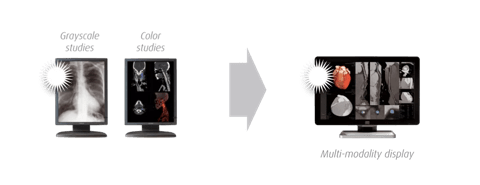What is a medical display?
A medical display is a monitor that meets the high demands of medical imaging. They are designed for a specific specialty: radiology, breast imaging, surgery, digital pathology, dentistry, ... Medical displays usually come with special image-enhancing technologies to ensure consistent brightness over the lifetime of the display, noise-free images, ergonomic reading and automated compliance with DICOM and other medical standards.
Medical display versus consumer display
Consumer displays promote specs that seem to approach those of medical-grade displays, and often cost less. But there is more to consider than just these specs. So why choose a medical display? First of all, medical monitors automate quality assurance and calibration to guarantee 24/7 compliance with medical standards and ensure maximum uptime. That's exactly what makes them so reliable.
In addition, the total cost of ownership for medical displays is often a lot lower than that of consumer displays, when you take into account installation and maintenance costs. Besides that, medical-grade displays present medical images with higher quality and more detail. What's more, they offer significant benefits when it comes to reading workflow and comfort.
Improved reading accuracy
- Brightness
- Noise
- Viewing angle
Brightness
Though recent consumer displays may seem to offer sufficient brightness at first sight, they tend to degrade quickly over time. Medical displays can go to 1,000 cd/m² or more but more importantly, their luminance output remains steady over time. This also means that compliance with DICOM 3.14 is guaranteed at all times.
Noise
Many medical-grade systems tackle noise issues via integrated uniformity technologies. These provide consistent brightness and improved grayscale presentation, ensuring better visualization of subtle radiographic abnormalities.
Viewing angle
Medical monitors are 100% ACR compliant across the screen, preserving a minimum of 350 cd/m², a high contrast ratio and excellent color values under different viewing angles.
Medical displays, workflow and comfort
Multi-modality imaging
Many diagnostic and breast imaging displays have been specifically designed for multimodality imaging. Their display form factor allows viewing of multiple modalities (both color and grayscale) on a single screen, enabling side-by-side comparisons and image fusions in no time, without switching monitors.

Ergonomic reading
According to a study by The MarkeTech Group, 87% of radiologists experience some form of physical discomfort when reading images. Some medical displays come with built-in features (to control ambient lighting or boost display brightness, for example) and non-reflective glass to improve reading ergonomics.
Some of the best medical monitors have been specifically designed to present images within the optimal field of vision to maintain effortless visual acuity. Medical screens are often bigger too so you can view an image in full on a single screen, without the need to pan or zoom. The scale-to-fit capability in many medical screens makes reading more efficient and ergonomic as well.

A medical display designed to present images within a radiologist's optimal field of vision.
Conclusion
Medical displays are preferred over consumer displays when used for medical imaging. The reason is simple: medical displays meet set requirements for image quality, medical regulations, and quality assurance.
